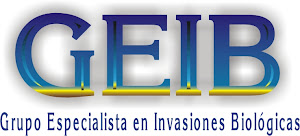 According to the CBD the term "introduction" refers to the movement by human agency, indirect or direct, of an alien species outside of its natural range (past or present). This movement can be either within a country or between countries or areas beyond national jurisdiction.
According to the CBD the term "introduction" refers to the movement by human agency, indirect or direct, of an alien species outside of its natural range (past or present). This movement can be either within a country or between countries or areas beyond national jurisdiction.Introductions could be:
Intentional: carried out deliberately by humans for specific purposes.
Unintentional: produced involuntarily, but always involving human means.
What is an alien species?
(Exotic=allochthonous=non native)
According to the Convention on Biological Diversity (CBD) the term "alien species" refers to a species, subspecies or lower taxon, introduced outside its natural past or present distribution; includes any part, gametes, seeds, eggs, or propagules of such species that might survive and subsequently reproduce.
The definition is based on ecological and biogeographical concepts but not on political or administrative basis.
Within a country an autochthonous species whose distribution range is circumscribed to a specific biogeographical area could become alien when introduced (intentionally or unintentionally) to other areas of the same country where it wouldn’t be present naturally.
What is an invasive alien species?
 According to the definition of the IUCN, an invasive alien species is an alien species which becomes established in natural or semi-natural ecosystems or habitat, is an agent of change, and threatens native biological diversity.
According to the definition of the IUCN, an invasive alien species is an alien species which becomes established in natural or semi-natural ecosystems or habitat, is an agent of change, and threatens native biological diversity.According to the CBD, invasive alien species means an alien species whose introduction and/or spread threaten biological diversity.
The definition refers only to those species whose introduction (intentional or unintentional) is always caused by human activities. Under no circumstances the terms refers to biological invasions that occur naturally (self-spread of a species).
All alien species become invasive?
Not all alien species become invasive. Many of them don’t have a significant impact and others are beneficial. It has been estimated that “only” a 5-20% of the introduced species could become invasive. Nevertheless, in spite of the small percentage, their impact is of great magnitude.
How do they get to a new place?
 Since the first human migrations, passing through the age of ancient civilizations and the epoch of great geographic discoveries, to modern and contemporary times, humans have moved for different reasons (nutrition, trade, science, etc.) an uncountable number of species.
Since the first human migrations, passing through the age of ancient civilizations and the epoch of great geographic discoveries, to modern and contemporary times, humans have moved for different reasons (nutrition, trade, science, etc.) an uncountable number of species.Many of them, although aliens, entailed great benefits and are part of the everyday life (tomatoes, potatoes, red peppers, etc.). Other species affected ecosystems in a tangible way (e.g. islands of the Mediterranean basin) although they have been introduced so many time ago they are considered to be part of the naturalised fauna that is often supposed to be autochthonous erroneously.
The number of introductions has exponentially increased in the last century, particularly in last decades. The human capacity for eliminating geographical barriers not only speeded up the “introductions phenomenon” but also has annihilated two dominant factors of biology and evolution: the time and scale.
Trade, transport and tourism are at present the three main factors which contribute to the intentional and unintentional movement of species, increasing in such a way the likelihood some of them could turn in a new invasive species.
The highest speed of the means of transport is a critical factor for the establishment of new species because it reduces the mortality rate during the process of transfer. Other factors which could influence the speed of colonization have to be added to the previous one e.g. the characteristics of the area of introduction and its degree of perturbation, the effects of climate change, etc.












